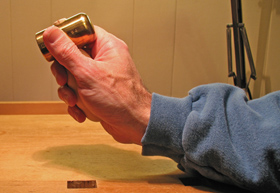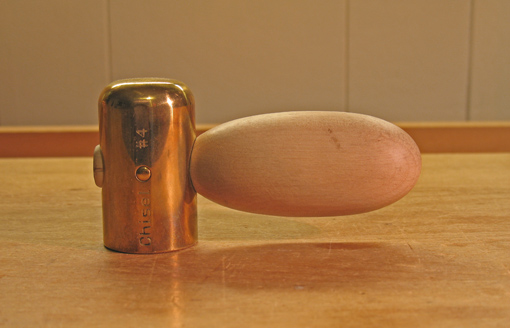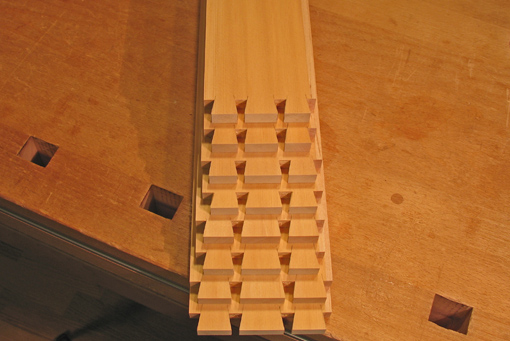I was long accustomed to using a classic joiner’s mallet to strike my chisels when I started using this brass mallet last year. It is a “Tite-Hammer” made by Glen-Drake Tools with a 14 ounce brass head and an ergonomic handle that must be held to be appreciated.
The wooden joiner’s mallet requires a large commitment of forearm movement and significant shoulder muscle involvement. This delivers the necessary punch when chopping a mortise with a heavy duty mortise chisel. However, for chopping dovetail waste and similar joinery tasks, a modest wrist movement with the Glen-Drake hammer easily supplies enough power. It’s somewhat like deftly tossing a crumpled ball of paper into a waste basket a few feet away, keeping the elbow low. This motion is less tiring and more efficient, especially when working in a seated position, which is generally how I like to chop dovetails. The mostly wrist action is also a better way to produce controlled, delicate tapping on a chisel without tensing the shoulders. This all makes a valuable contribution to my ease and endurance in the shop.
There are additional features of this tool. Since it occupies a only a small space on the bench, it is easily placed down and retrieved close to the work. The brass head is relatively kind to edge tools. I like the flat face of the head for chopping, while the rounded face comes in handy for other tasks such as tapping together joints.
When I pick up this unassuming tool, it feels like it is just growing out of my hand. The contours of this tool must have been designed, not at a drafting table, but with trial and error, a rasp, and learned hands. It is assembled with a nifty wedged through-tenon and a brass pin through the head. It’s simple and works beautifully, so, yeah, it’s my kinda tool.
I find the 14 ounce, the largest of four available sizes, packs a good wallop but is easily maneuverable with a light touch and does not tire me at all. I do not have a personal or financial interest in the company; my recommendation is based on personal experience and presented for the benefit of my fellow woodworkers.
I will continue to laud some of my favorite tools on this blog, particularly if I think they are not well known or are underappreciated.




Rob: Well you’ve exposed me to a new type of hammer. Thanks. There seems to be no end to the ingenuity of tool designers. I forget which blog I was visiting last week, but the discussion was about commonly sold chisels and how they must often be modified once purchased. Odd that the big manufacturers haven’t caught on and been more proactive about tuning their offerings. — Keith (woodtreks.com)
Keith,
As we know, the best tools are not coming from the big manufacturers, who mainly market to people who do not want, or maybe don’t recognize, quality tools. Fortunately, now with enough craftspeople who appreciate quality, the small to mid-size toolmakers should continue to flourish.
This is a good time to be a woodworking tool consumer!
Rob
I just purchased one of these hammer at the WIA conference. Two tips that Kevin Drake gave me is to put your index finger on the top of the hammer when using for max control. He also said the rounded end is for hitting square objects and the square end for rounded objects. He says this allows for the max transfer of energy. I have not used mine yet as it is a Christmas present, but I am certainly looking forward to testing it out.
Steve
Steve,
Yes, I use the flat end to strike the rounded tops of my Japanese bench chisels, and the rounded end for tasks such as lignt assembly work (with a softwood protective block).
Enjoy your Christmas!
Rob
Thanks for the write-up! Looks like a pretty spiffy hammer. Another item for the wish list :).
Yea, I use it far more than any other tool to strike chisels.
Rob